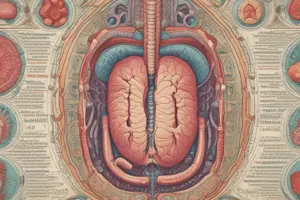Podcast
Questions and Answers
Where does most of the food digestion and nutrient absorption occur?
Where does most of the food digestion and nutrient absorption occur?
- Large intestine
- Stomach
- Liver
- Small intestine (correct)
Which organ produces digestive juices and the hormone insulin?
Which organ produces digestive juices and the hormone insulin?
- Gallbladder
- Liver
- Stomach
- Pancreas (correct)
What is the function of the gallbladder in digestion?
What is the function of the gallbladder in digestion?
- Produces digestive juices
- Processes impurities and toxins
- Stores and concentrates bile (correct)
- Breaks down carbohydrates
What is the role of gut flora or the microbiome in digestion?
What is the role of gut flora or the microbiome in digestion?
Which system contributes to the digestive process by controlling food movement and releasing digestive juices?
Which system contributes to the digestive process by controlling food movement and releasing digestive juices?
What is a common digestive system problem where stomach contents back up into the esophagus?
What is a common digestive system problem where stomach contents back up into the esophagus?
Where does digestion start?
Where does digestion start?
What is the function of the gastrointestinal tract?
What is the function of the gastrointestinal tract?
What does saliva contain that helps in digestion?
What does saliva contain that helps in digestion?
Which organ mixes food with gastric juices to break down proteins?
Which organ mixes food with gastric juices to break down proteins?
What is peristalsis?
What is peristalsis?
What is the first part of the small intestine called?
What is the first part of the small intestine called?
Flashcards are hidden until you start studying
Study Notes
The Digestive System
The digestive system is a complex network of organs, tissues, and glands that help the body break down food and absorb nutrients. It plays a crucial role in ensuring the body receives the necessary nutrients for energy, growth, and repair. The digestive system is made up of the gastrointestinal tract, which is a long, twisting tube from the mouth to the anus, and the liver, pancreas, and gallbladder.
The Gastrointestinal Tract
The gastrointestinal (GI) tract, also known as the digestive tract, is a series of hollow organs that start at the mouth and end at the anus. It consists of the mouth, esophagus, stomach, small intestine, large intestine (including the rectum), and anus. The GI tract helps to move food and liquids through the body, break food into smaller parts, and absorb nutrients into the bloodstream.
Digestion Begins in the Mouth
Digestion starts in the mouth, where food is ground up by the teeth and moistened with saliva. Saliva contains an enzyme that starts breaking down carbohydrates into sugars. Once swallowed, the food passes into the esophagus, where muscular contractions called peristalsis move the food down into the stomach.
The Stomach and Small Intestine
In the stomach, the food is mixed with gastric juices, which help break down proteins. The stomach churns the food, both mechanically and chemically, and then squeezes it into the first part of the small intestine, called the duodenum. The small intestine is where most of the food digestion and nutrient absorption occur. The food is mixed with digestive enzymes from the pancreas and bile from the liver, which help break down carbohydrates, proteins, and fats into their simplest forms. Nutrients are absorbed through the walls of the small intestine and into the bloodstream.
The Large Intestine and Anus
Once all the nutrients have been absorbed, the waste products of digestion move into the large intestine. Water is absorbed, and the waste, now in the form of stool, is stored in the rectum. The stool is then passed out of the body through the anus.
The Liver, Pancreas, and Gallbladder
The solid organs of the digestive system, the liver, pancreas, and gallbladder, also play essential roles in digestion. The liver processes proteins and carbohydrates, breaks down fats using bile stored in the gallbladder, processes impurities, drugs, and toxins, and generates glucose for short-term energy needs. The pancreas produces digestive juices and a hormone called insulin, which helps regulate blood sugar levels. The gallbladder stores and concentrates bile, which is released into the small intestine to aid in the digestion of fats.
The Role of Bacteria and Nervous and Circulatory Systems
Bacteria in the GI tract, also known as gut flora or the microbiome, play an important role in healthy digestion. Parts of the nervous and circulatory systems also contribute to the digestive process by controlling the movement of food through the GI tract and the release of digestive juices.
Common Digestive System Disorders
Some common digestive system problems include colitis (inflammation of the bowel), diverticulitis (inflammation of pouches lining the small intestine), gastroenteritis (an infection causing vomiting and diarrhea), heartburn (when stomach contents back up into the esophagus), and ulcers (holes in the mucous membrane lining the stomach or duodenum).
In conclusion, the digestive system is a complex network of organs and tissues that work together to break down food, absorb nutrients, and eliminate waste. It is essential for maintaining the body's health and energy levels.
Studying That Suits You
Use AI to generate personalized quizzes and flashcards to suit your learning preferences.




